Research conducted at Harvard University that involves human subjects is required to follow certain Federal Regulations and Harvard policies. This page highlights certain basic information about the requirements, and contains links to sources of additional information.
How do I know if my research needs to be submitted to CUHS?
Broadly speaking, research must be submitted to CUHS if you plan to interact with people or obtain identifiable data about them.
If you are not sure that your research even involves human subjects in this way, you can use HRP-213 Not Human Subjects Research Determination Request (found in the ESTR Library) as a guide. This is the form you would submit through ESTR if official determination is needed from a funder or for documentation purposes.
If your research does involve human subjects, then it must be reviewed by CUHS. No research activities may begin until the CUHS review has been completed.
What do I do if my project does need review?
You must prepare a protocol that describes your research and submit it to CUHS through ESTR. Download a copy of the CUHS Protocol Template (found in the ESTR Library) and complete all the questions. In most cases, you will also need to submit some consenting material; choose the appropriate document(s) as a starting point.
Note that the requirements for consenting depend on the type of research. There is a category of research called “exempt” that has simplified consenting requirements. For more information on these requirements, please contact CUHS. Briefly, exempt research involves either studying normal educational practices or surveys or interviews/surveys about non-sensitive topics or collecting no identifiable information.
Most research is reviewed by CUHS staff on behalf of the Committee, but certain complex or risky research requires review by the Full Committee, which meets once a month. Meeting dates and submission deadlines for Full Committee review are found by clicking the "Meetings" menu item on the left.
What happens after I submit to CUHS?
The ESTR program allows you to track the progress of the CUHS review. First, you can check that you actually submitted the research – it is possible to finish editing the draft application and save it rather than submit it. It is also important to keep track of whether CUHS staff need more information from you – your study will be in “Clarifications Requested” status and no more action will be taken until you provide the information requested. In addition, the review cannot be completed if you are a non-Faculty investigator until your Faculty Sponsor has approved it through ESTR.
ESTR will show you the status of your study throughout the review process. To find out when review is complete, you can check ESTR regularly or when you receive an email notification.
What happens after review is complete?
This depends on whether your research received an exempt determination or an approval:
- Exempt determination – the only time you must communicate with CUHS is if there is a serious problem or if you plan to change the research project in such a way that it may no longer be exempt (for example, interviewing children).
- Approval – you must communicate with CUHS if
a. you plan to change the research in any way – you must submit the modifications for review prior to implementing any changes
b. your project ends – you must submit for study closure
c. an adverse event or noncompliance occurs – you must notify CUHS through the “Reportable New Information” function of ESTR
Where can I get more information?
- Call (617-496-2847) or email CUHS
- Visit the Resources page for references and links.
- Visit the ESTR Support page for information about ESTR.

